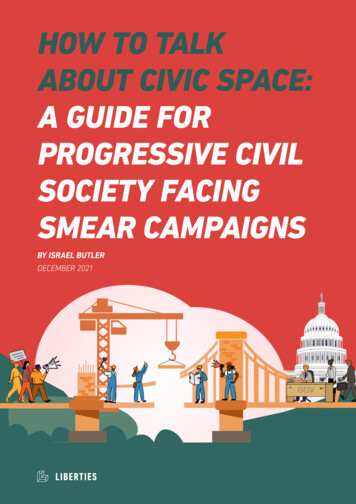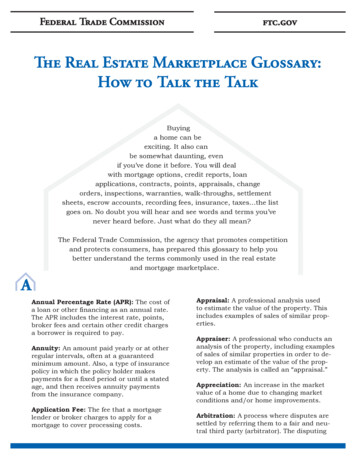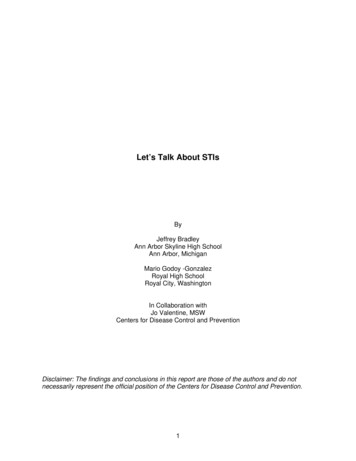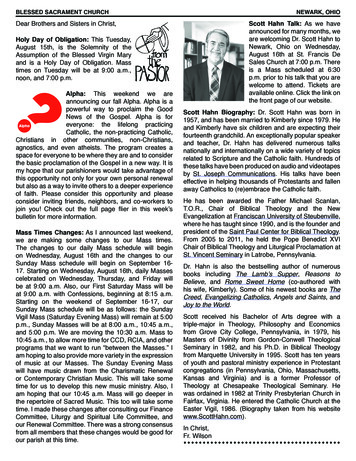
Transcription
HOW TO TALKABOUT CIVIC SPACE:A GUIDE FORPROGRESSIVE CIVILSOCIETY FACINGSMEAR CAMPAIGNSBY ISRAEL BUTLERDECEMBER 20211
TABLE OF CONTENTSExecutive summary4I.About this guide8A. Why write this guide now?8B. Who is this guide for?8C. Where do narratives fit into campaigning?9D. How is the guide structured?9E. Terminology9II.What influences public attitudes towards CSOs?A. What do we know about public attitudes on CSOs?1212i) Attitudes towards CSOs12ii) What can we take from this?13iii) Factors affecting trust towards CSOs13iv)What can we take from this?14B. What role do values play in stimulating support for progressive causes?15C. Should I try to persuade the whole of the public?17III. Narratives that can stimulate support for CSOs and the causes they work on18A. Values statement21B. Explanation of the problem28C. Explanation of the solution31D. Call to action and reminder of past successes32E. What a narrative looks like when you put all the pieces together33IV. Smear campaign narratives and how not to respond to them35A. Your opponents’ messaging is calibrated to destroy trust and stimulate authoritarianattitudes35B. Some mistakes to avoid when you react to smear campaigns37i) Don’t repeat unhelpful frames37ii) Don’t use myth-busting, use a truth sandwich instead39iii) Don’t co-opt the kinds of arguments used by your opponents: they’re likely to triggervalues and worldviews that underlie authoritarian attitudes40iv) Don’t only focus on the problem43v) Don’t use technical or abstract language to engage the public43Get in touch45Annex: Review of research into public attitudes on CSOs and the factors that influencetrust towards them46Endnotes58
The author is very grateful to James Robertson for his review of and feedback onthis guide. The author is also grateful to James Savage, Vera Mora and Rebeca DíezEscudero for their comments. This guide draws on the indispensable work and guidance on narratives of others in parallel fields of social justice, particularly the work ofAnat Shenker-Osorio. All mistakes remain those of the author. The author welcomesfurther comments or insights that readers believe could make this guide more usefulfor campaigners.This work is licensed under the Creative Commons Attribution 4.0 InternationalLicense. To view a copy of this license, visit http://creativecommons.org/licenses/by/4.0/ or send a letter to Creative Commons, PO Box 1866, Mountain View, CA94042, USA.
EXECUTIVE SUMMARYPolitical parties, nonprofits, churches,social movements and media outletswith authoritarian agendas are attacking progressive causes like humanrights, social justice, environmentalprotection and equality, and the institutions that protect and promote them,including civil society organisations(CSOs). One of the reasons that authoritarian forces are able to advancetheir agendas is that they are adept atcommunicating in a way that mobilisestheir supporters and sways persuadableparts of the population over to theircause. Unfortunately, CSOs and otherswho promote progressive causes havedifficulty developing messages that fireup their base and persuade people outside their existing supporters. If CSOsare to preserve and expand the vital rolethey play in protecting and advancingprogressive causes, they need to buildgreater support among the public forthe work they do.This guide is a tool for campaignerswho wish to push back against smearcampaigns aimed at destroying publictrust in CSOs that promote progressive causes. The recommendations andfindings are also likely to be useful forthose working in academia, nationalhuman rights institutions and international organisations that promote andprotect progressive causes like humanrights and are interested in engaging apublic audience. As well as constitutingintimidation of themselves, smear cam-paigns are often used by authoritariangovernments and their allies to createpublic support for (or depress resistanceagainst) regulatory measures to inhibitthe work of CSOs.The guide includes: A summary of research on publicattitudes towards CSOs and whatfactors affect public trust towardsCSOs. Examples of narratives, frames andmessages that campaigners canadapt to their particular circumstances. An explanation of what kinds ofarguments and habits campaignersshould avoid using. For those wishing to dig deeper, anAnnex containing a review of research into public attitudes towardsCSOs.This guide has been written with thesituation facing CSOs inside the EU inmind. However, it is likely that muchof the messaging advice is relevantfor campaigners in other parts of theworld.Below is a summary of the principlesof good communications on this topic,drawn from the contents of the guide.4
Don’tDoRepeat damaging frames by using your opponents’ framing. When you directly contradictyour opponents, you will usually be reinforcingtheir negative framing.Lead with what you want to say. Check whetherthe terminology and framing you’re using isworking against you and re-frame if necessary.e.g. Hypothetical situation:e.g. Reframed response that says what you stand for:The government proposes a ‘Law on political interference’ aimed at removing public benefit status fromCSOs working on progressive issues.Most of us want representatives who listen to our concerns so that they can govern for all of us. We make itpossible for those of us who want to, to come togetherto talk to our leaders about what we find important.Response that accidentally reinforces the damagingframe:‘Although CSOs talk about political issues, we do notinterfere in politics. And we have much less influencethan corporate lobbyists.’Use a myth-busting approach for addressingsmears. Myth-busting involves repeating youropponents’ frame, which will reinforce it.Use a ‘truth sandwich’ instead: a) lead with whatyou want to say b) allude to, but don’t repeat, youropponent’s smear and explain their malign motive and c) come back to your main message.e.g. Hypothetical attack:e.g. Truth sandwich response:Activists are spreading an ideology that harms ourchildren. We must stop this propaganda.We are not spreading harmful propaganda. Recognising LGBTQI persons is not an ideology. It is ahuman right recognised in international law andour constitution that every person should be treatedequally, no matter their gender identity or sexualorientation.No matter who we vote for, most of us agree that ourleaders should govern for all of us. But some politicians are so desperate to hold onto power that they tryto divide us based on who we love. They hope we’llbe too busy blaming each other to realise the problemsthey’ve caused while they’ve been in power. But weknow, no matter who we love, most of us want thesame things, like being able to support our familiesand pay the rent. When we unite across our differences, we can demand leaders who work for all of us.That’s what this government is afraid of.Focus only on describing the harms of the problematic situation. Your audience will tend tointerpret bare facts according to their ‘commonsense’, which may include the content of smearcampaigns.When you explain the problem, break down whois doing what or what systems are in place thatallow that harm to happen. If relevant, pointto the motives behind those responsible for theharm.e.g. Explanation of the problem that merely listsharms without explaining the agency:e.g. Explanation of the problem that explains theagency:The government is harassing us. The justice ministryhas ordered tax inspections of 20 CSOs in the past 2years. It has cancelled grants for and stopped existingcooperation agreements with CSOs offering legal andintegration assistance to asylum seekers. Now we arebeing forced to publish lists with the details of all ourdonors on our website.The public services that our communities depend onare crumbling, because politicians in the ruling partyare pocketing our resources for themselves instead offunding the things we need. To distract people fromtheir failings, they’re pointing the finger for theseproblems at people who come to our country and atorganisations like ours who help people who migratebuild a new life.Myth-bust response:If your audience’s main understanding of CSOscomes from government smears about corruptionand mismanagement, they may well interpretthis list of harms as proof that CSOs aren’t trustworthy.5
Don’tDoTalk only about the problem. This can overwhelmyour audience and make them feel like the situation is inevitable or cannot be solved.Remind your audience of what the situationshould be and what the world should look like.Once you’ve explained the problem, show themthat there is a solution that they can support.e.g. Message that focuses only on the problem and thesituation that we do not want:e.g. Message that balances the problem against ourvision and solutions:The ministry has excluded CSOs from taking partin planning decisions. This means that only corporations will have a voice before the committees thatdecide whether to sell them public land and build onit. Within a decade it will be impossible to enjoy ourbeaches unless we can afford to pay the entry pricesdemanded by a private park or hotel owner.Most of us look forward to summer days on the beachwith family and friends. CSOs have spent the last 50years making sure that all of us can enjoy our seasidesby blocking planning decisions to sell off the coast.Now the ministry wants to kick us out of planningdecisions so they can sell our beaches off to their corporate friends to build fancy hotels. Only the wealthywill be able to afford to enjoy our beaches. Let’s keepCSOs on the planning committee so that our childrenand grandchildren can continue to enjoy days at thebeach like we have.Talk about marginalised groups in a way thatmakes them seem separate from your audience.This will perpetuate othering.Appeal to the shared humanity of people fromthe marginalised group by reminding your audience of what we have in common. Stimulateempathy with shared values, shared experiencesand by bringing the issue closer to your audienceand people they care about.e.g. One in three women experiences violent or sexualabuse. We must ratify the Istanbul Convention tostop women and their children suffering harm.e.g. When we think of the women in our lives whoare in relationships, we hope they’re with partnerswho love and respect them. But some of us can endup in a crisis marriage where things aren’t working,and a woman and her children are in real danger. Weneed to show care and compassion and offer them aroute to safety. One day your sister, daughter, granddaughter or friend might need it.Use technical abstract language for non-expertaudiences. This will make your audience tune outand makes it harder for them to connect the issueto shared values.Break down the standards you’re promoting bypointing out how they bring to life things thatyour audience finds important.e.g. The right to freedom of association is guaranteedin international law and our constitution. It guarantees citizens the right to form and run an association, and to receive funding.e.g. When we work together we can accomplish biggerthings than if we work alone. We have the right tocreate organisations so we can come together withlike-minded people. Whether that’s to play sports,negotiate a better wage with our employer, or talk toour leaders about our concerns.6
Don’tDoFocus your messaging on how honest, transparentor well-managed your CSO is. This can backfireand instil or reinforce the idea that CSOs are nottrustworthy.Even when you’re facing smears about corruption or mismanagement, focus your messagingon the values you promote and how these have atangible impact on your audience’s lives. Addressdisinformation using a ‘truth sandwich’ format.e.g. Our organisation is fully accountable and our finances are transparent. We are audited every year byindependent accountants to check that all our fundsare spent legally. Most of our funding comes from foreign governments and foundations. They also checkcarefully that we spend all their funds in line withrigid safeguardse.g. No matter who we vote for, most of us agreethat the leaders we elect should do what is best foreveryone. But some politicians are passing laws thatjust help corporations who donate to their party. Likecutting taxes for businesses that should be contributing their fair share to fund our schools and hospitals. They don’t like it when we call them out on this,so they try to make voters distrust us. We will continue to give you the information you need to workout if your representative is working for you or justfor themselves.Rush into relying on the argument that CSOsare beneficial for the economy, security, tradition,religion, or your country’s standing in the worldwhen talking to a broader public audience. Unless they are carefully phrased, these argumentswill tend to demotivate your base and move persuadable audiences in the wrong direction.When speaking towards a broader public audience, root your messaging in favour of CSOs inarguments about how CSOs help give peoplecontrol over their lives, allow citizens to work together and care for each other, and help us createa society where we all have the same chances todo well in life.e.g. Our organisations are helping to keep down crimebecause we are promoting a more equal society. Whenpeople have more opportunities to do well in life, theyare less likely to resort to crime for an income.e.g. Most of us want the same things, like a job thatallows us to support our families and to be in goodhealth. We’re working with citizens to make surethat all of us have the same chances to do well in life.Whether that’s having roads and buses that get us towork, or schools that give our kids the best start inlife.7
I. ABOUT THIS GUIDEA. Why write this guidenow?Progressive civil society organisations(CSOs) are a vital part of the infrastructure that promotes causes likehuman rights, equality, social justiceand environmental protection. Thisguide is a tool for progressive CSOs tostimulate public support for the causesthey promote and for the role theyplay in making democracy work foreveryone.During the last decade in the European Union, political parties, socialmovements, religious bodies, mediaoutlets, think tanks and CSOs promoting authoritarian agendas havegrown in strength and popularity. Theyhave succeeded in halting or reversingprogressive gains on a range of issuessuch as equality for women, LGBTQIpersons and ethnic minorities, environmental protection, media freedom, therule of law and democratic participation. As well as weakening progressivestandards, authoritarian forces attackthe infrastructure that protects andpromotes them, such as progressiveCSOs.One reason for their success is thatauthoritarian forces are adept at communicating in a way that stimulatespublic support for and depresses resistance against their retrogressive agenda.Unfortunately, progressive CSOs donot tend to communicate in a way thatpeople outside their existing supporters find persuasive. When authoritarian forces can increase public supportand de-motivate resistance, they canimplement their agenda more easily.To preserve and promote progressivecauses, CSOs need to resist limitationson and expand their freedom to operate. Which means they need to buildgreater public support for the causesthey promote and the role they playin facilitating democracy. This guideoffers progressive CSOs messagingthey can use to grow public support.B. Who is this guide for?This guide is for campaigners whowish to mobilise public support infavour of CSOs advancing progressivecauses, particularly when facing smearcampaigns and restrictions on theiractivities. The guide sets out narratives,frames and messages that activists canuse for inspiration in their communications when campaigning. The guide hasbeen written for campaigners workingin EU member countries, and theguide’s advice has been written withan EU context in mind. However, it islikely that the recommendations andfindings in the guide remain useful forcampaigners working in other regions,even if they require some adaptation tolocal circumstances. The recommendations and findings are also likely to beuseful for those working in academia,8
national human rights institutions andinternational organisations that promote and protect progressive causeslike human rights and are interested inengaging a public audience.such as advocacy, litigation and publicmobilisation.C. Where do narratives fitinto campaigning?The guide begins with a brief outlineof public attitudes towards CSOs, andan explanation of the factors that influence opinions on CSOs; in particular,the role that shared values play instimulating trust. It then gives recommendations for narratives, frames andmessages that campaigners can use andadapt to their particular contexts. Theguide then explains how your opponents communicate, why they chooseparticular messages, and sets out thekind of messaging campaigners shouldavoid and why. For those interested infurther detail, annexed to the guideis a review of research into the factorsthat influence how the public formsattitudes about civil society.The narratives suggested in this guideare not final communications products.They are intended to be used as the basisfrom which campaigners can developtheir communications products, suchas videos, images, interviews and articles that convey their stories and messages. Campaigners should also takeinto account that a compelling narrative is only one element of a campaignstrategy. For example, campaignersneed to set measurable and achievablegoals, determine which audience theyshould target to achieve these, learnabout the views of that audience andhow best to reach them. This includesunderstanding which channels to use,what kinds of communications products their audience prefers and whatmessengers are credible to them.Depending on the resources availableto campaigners, changing the public’sway of thinking and the narrativesthat dominate public debate can takeyears. A one-off campaign in reactionto smear attacks, even if well crafted,is unlikely to be enough. This is whyCSOs should treat narrative changeas a continuous line of work that complements and is reflected in other toolsD. How is the guidestructured?Although the narratives, frames andmessages in this guide have beendeveloped using the best availableresearch and expertise in progressivecommunications, they have not beentested. Campaigners are encouraged totest the suggestions in this guide, anddevelop creative outputs from thesenarratives that they can test with theirtarget audiences.1E. TerminologyThis guide uses certain terms to meanspecific things that might not befamiliar to readers or that might mean9
different things to the reader thanintended by the author. For clarity,here are explanations of what the guidemeans when it uses particular terms.A civil society organisation (CSO)refers to campaigners, activists, movements and organisations that promoteprogressive causes such as humanrights, anti-corruption and environmental protection. It’s not the author’sassumption that CSOs only promoteprogressive causes. Rather, the termCSO appears so many times in the textthat specifying ‘progressive CSOs’ onevery occasion makes the text harderto read.CSOs can be labelled in many ways.For example, ‘activist’, ‘movement’,‘NGO’, ‘rights group’, ‘campaigner’,‘civic organisation’. The guide picksone term for consistency and to avoidconfusion. This doesn’t mean thatcampaigners should necessarily usethis term in their communicationsto refer to themselves. You should beaware that the terms you normally usemay have acquired negative connotations because of smear campaigns.For example, research in Italy in 2017(when NGOs were under fierce attackfor rescuing people who migrate) foundthat people reacted more negatively tothe word ‘NGO’ by comparison to theword ‘volunteer’ or ‘voluntary associations’.2 Research in Canada also foundthat levels of trust towards NGOsdiffered depending on whether theywere described as working on ‘socialjustice’, ‘human rights’, ‘development’or ‘poverty’.3 Whether the terms campaigners use have positive or negativeconnotations will depend on publicdebate in their country. This meansit’s entirely feasible that the same termcould provoke different reactions indifferent countries.Campaigners should consider testinghow people in their country react todifferent terms. If the term you usuallyuse has become a liability, then it maybe time to start using another label andagree with other CSOs to populariseit.Values refers to deeply held guidingprinciples that determine how we seethe world, what we think is importantand our attitudes, which in turn havean influence on our behaviour. Valuestend to work in the background, andwe tend not to be consciously aware ofthem. The messages that people hearrepeatedly can trigger and reinforcecertain values, which then have animpact on their attitudes.A narrative refers to a line of reasoningthat follows a specific four-part structure (values – problem – solution – callto action), that is designed to persuadeyour audience to support your positionand act on it. A narrative frames thevalues, problems and solutions in a waythat draws your audience to adopt yourunderstanding of the phenomenonyou’re dealing with. For example, anarrative on marriage equality mightgo something like this: a) all of us haveexperienced love and most of us want10
the freedom to commit long-term tosomeone we love; b) but the law deniesthis to some of us, just because we lovesomeone of the same gender; c) we canchange the law so that our grandchildren and children can grow up beingable to commit to the person they loveregardless of their gender; d) vote ‘yes’in the upcoming referendum. Chapter III (Narratives that can stimulatesupport for CSOs and the causes theywork on) explains in greater detail theingredients of a narrative and includesexamples for readers to adapt and use.A frame refers to a mental model orshort-cut. For example, if you thinkof a restaurant, it contains certain features (tables, waiting staff, a place toorder and eat food) and excludes others(a doctor and an operating table). Inthe above example, marriage is framedas freedom to commit to a personyou love. The law is framed as unfairand non-sensical for failing to reflectwhat marriage is about. The solutionis framed as an act of love and caretowards our own families that we canrealise by changing the law.between the couple and how this isthe same for heterosexual couples. Thelatter promotes the narrative outlinedearlier better than the former.A story refers to an account of something happening with a beginning,middle and an end. A message doesn’tneed to have this structure and canmerely be a statement observation orslogan that captures the core of thenarrative.Authoritarian refers to an anti-humanrights, equality, democracy, rule oflaw, environmental protection agenda.Progressive refers to being pro-humanrights, equality, democracy, rule of lawand environmental protection. Theseterms are not used in a party-politicalsense. It’s possible for parties on the leftand the right of the political spectrumto promote authoritarian or progressive agendas. In this sense, all membercountries of the European Union havecommitted themselves to a progressiveagenda, since all these principles arerecognised as founding values, goals orlegal standards of the EU.4(Values-based) Framing refers to theprocess of shaping a story or a messagethat promotes a particular narrative. Intelling a story of a same-sex couple whoaren’t able to have their relationshiplegally recognised, one could choose tofocus on how the couple is unable to gethold of that piece of paper that certifiesa partnership that many of us take forgranted. Or one could instead chooseto focus on the love and commitment11
II. WHAT INFLUENCES PUBLICATTITUDES TOWARDS CSOS?This chapter sets out what we knowabout how people form their attitudeson CSOs and progressive issues ingeneral. It begins with a summary ofresearch into public attitudes on CSOs;in particular, what ways of thinkingpeople have about CSOs and what factors influence trust towards CSOs. Thisis primarily based on research coveringEU countries, though it is likely thatmany of the findings, for example ontrust, remain valid for other regions ofthe world. An in-depth review of thisresearch is available in the Annex tothis guide. This section also explainshow public attitudes are influenced bythe values that people prioritise.A. What do we know aboutpublic attitudes on CSOs?When developing narratives, campaigners should take existing publicattitudes and ways of thinking intoaccount so they know what ways ofthinking they need to dissolve andwhat they can build on. Unfortunately,only a handful of surveys give us apeek into what people think of CSOsacross the EU. Research concerningattitudes towards CSOs is patchy.Some surveys ask respondents whatthey think of CSOs in general. But it’slikely that attitudes towards CSOs areaffected by what topics they work on,which is something these surveys don’ttell us. Other surveys are more focusedand look at particular CSO sectors inparticular countries. But the numberof these studies is low, so we don’t havea comprehensive picture.i) Attitudes towards CSOsHaving said this, it’s possible to extractsome general ideas about what peoplethink of CSOs. Broadly speaking, CSOs areoften see as more trustworthy andethical than other institutions,like government, business and themedia. The public also seems to havesome understanding that CSOsplay a role in making democracywork and that sometimes governments try to stop them doing theirjob. There is also evidence that thepublic sees activists themselvesnegatively, considering them to bemilitant, dictatorial and generallyunpleasant. Furthermore, when thepublic thinks that an activist fits thisnegative stereotype, they becomereluctant to support their cause.12
ii) What can we take from this? The idea that CSOs are considered relatively ethical and trustworthy and that they play a role infacilitating democracy is a way ofthinking that campaigners need toencourage in their audience. Campaigners can do this by communicating how CSOs promote sharedvalues, such as allowing people tojoin together to demand that leaders hear their concerns and work foreveryone.voice in a broader movement. Ifthis is not the case, campaignerscan counter negative stereotypes byadjusting their tone, having more ofa dialogue about people’s concerns(rather than telling people whatthey should think) and choosingthe right messengers.iii) Factors affecting trusttowards CSOsThe suggested narratives, framesand messages in Chapter III (Narratives that can stimulate supportfor CSOs and the causes they workon) of this guide will give furtherexamples of how to implement bothof these takeaways.Most existing research tells us notwhat opinion people have of CSOs, butrather what factors shape their opinions. And in particular, what factorshave an impact on trust towards CSOs.Trust is probably the key connection totheir audience that CSOs need to cultivate. Research shows that people whotrust CSOs are more likely to supportthem and the causes they promote. Forexample, by donating, volunteering,defending them from criticism, participating in protests and campaigns,or repeating their messages to others.5The messaging used by authoritariansto smear CSOs is calculated to undermine trust in CSOs. When publictrust towards CSOs is low, it becomeseasier for authoritarian governments tofurther harass them and restrict theiractivities because they face less resistance from voters. The negative images associatedwith the stereotypical activist maybe a way of thinking that campaigners want to dissolve. Unless,of course, they have taken a strategic decision to be the more radicalTrust is mostly built on shared values.If your audience sees that you promotethings that they find important, they’remore likely to trust you. This meansthat CSOs should focus on communicating the values that they promote and The recognition that governments sometimes try to stop CSOsdoing their job is also somethingcampaigners can build on byexplaining that when governmentsimpose restrictions on and smearCSOs, they do so for malignmotives. When CSOs expose theulterior motives behind disinformation, it makes it more likely that thepublic will reject the disinformation.13
how they put this into practice. SectionB (What role do values play in stimulating support for progressive causes?)of this chapter picks out in more detailwhich values to focus on to promotesupport for progressives causes, andChapter III (Narratives that can stimulate support for CSOs and the causesthey work on) gives examples of narratives, frames and messages that arelikely to convey these values. It seems likely that trying tostimulate trust by focusing yourcommunications on how accountable, responsible and transparent aCSO is, is likely to backfire. Whenyou audience shares your values,they will trust you. Talking aboutsafeguards like transparency makesit seem like you’re not trustworthy,because it can make your audiencequestion why you needed to createaccountability mechanisms to beginwith. In the EU, where CSOs areprobably more engaged in advocacy or in providing services tomarginalised groups (rather thanthe mainstream population), campaigners cannot expect people toinstinctively understand how theirwork connects to shared values. As common sense might suggest, negative media coverage andsmear campaigns influence levels oftrust towards CSOs, and levels oftrust towards CSOs vary from onecountry to another. Even duringtimes of smear campaigns whentrust may fall, it seems that a certain level of trust in CSOs alwayspersists.iv) What can we take from this? In situations where CSOs havenot been smeared as corrupt or mismanaging thei
the marginalised group by reminding your au-dience of what we have in common. Stimulate empathy with shared values, shared experiences and by bringing the issue closer to your audience and people they care about. e.g. When we think of the women in our lives who are in relationships, we hope they’re











